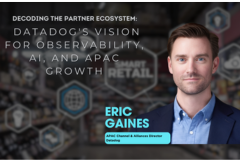Venkatraman Swaminathan, VP & Country GM, IT Division, India & SAARC, Schneider Electric, spoke to Amit Singh on the slew of opportunities for channel partners, and cost savings and RoI with IoT and edge computing solutions
What is the current readiness of the connected things to utilize the full potential of IoT and edge computing in India?

According to Deloitte, IoT in India will go beyond the shop floor and become an essential part of B2B value proposition and pricing models. By 2020 the number of IoT units in India is expected to cross 1.9 billion with a market potential of over $9 billion.
There is a substantial push from the government of India towards digitization, which has been further strengthened during the recent budget announcement with doubling of its investments in technology research & development. The drive towards Smart Cities, which has its foundation on digital infrastructure – clearly highlights India’s vision towards becoming a more sustainable, efficient and livable country.
Businesses in India are realizing the wide-reaching benefits of IoT implementation. With the aim to bring in operational efficiency, reduce cost and to ensure sustainability, organizations across industries are embracing digital innovations such as IoT, edge computing, artificial intelligence, block-chain, and robotics.
Further, edge computing allows data produced by IoT devices to be processed closer to where it is created instead of sending it across long routes to data centers or clouds. This, lets organizations analyze important data in near real-time. Research firm IDC predicts that by 2019, at least 40 percent of IoT-created data will be stored, processed, analyzed and acted upon close to or at the edge of the network, globally.
What are the customer expectations and awareness around IoT and edge computing in India?
Most of the industries like utility, IT infrastructure, energy and even retail, today need real-time intelligence for enhanced customer experience. Some of the key benefits that are driving industries towards the adoption of edge computing include real-time intelligence, analytics that impact the bottom line by collecting instant data, disaster management, and predictive maintenance.
At Schneider Electric, we help our customers make their data centers, buildings, homes, manufacturing processes, and the grid more efficient with digital innovations at every level. By bringing together automation, and software, our IoT-ready EcoStruXure architecture delivers on this promise through connected products, edge control, apps, analytics, and services.
What are the potential opportunities you see for channel partners around IoT and edge computing over the next 3-5 years?
Pharmaceuticals, life sciences and automobile are few of the many industries to adopt IoT and edge computing. With several IoT devices being deployed, the data volumes generated are growing manifold. This indeed brings an explosion of opportunities for channel partners as growth in these technologies accelerate. Providers in SaaS and hosted services, network aggregators and managed service providers (MSPs) will be greatly benefited with the multiple opportunities which lie ahead.
Both IoT and edge computing require real-time collection and analysis of data which is supported by cloud infrastructure. Along with on-premise support, organizations will require a system in place to maintain, monitor, secure IoT applications and ensure optimal performance. All our partners have the experience of delivering solutions for these essential requirements.
On the other hand, the edge creates ample new revenue opportunities for network integrators, MSPs, and IT solution providers. Customers will look to their providers to help them set and manage their edge assets.
Please elaborate on the savings and RoI around IoT and edge computing solutions.
Organizations are realizing the potential of IoT and edge computing in driving businesses, bringing in operational efficiency and cost savings. For companies, it is today possible to connect a spectrum of assets to a central cloud at marginal costs, thereby optimizing the overall asset performance and reliability. This, in turn, has a positive cascading effect which impacts every other related process and output across the organization.
Schneider Electric’s EcoStruxure IT is a platform that combines connected products, edge control, applications, analytics, and services. Many years in the making, the EcoStruxure IT architecture allows data center operations staff to leverage advanced level of IoT-driven connectivity and to create business value from it. The scope of EcoStruxure IT extends beyond the traditional data center white space: building elements (heating and cooling) and power elements (large power equipment in the electrical room).
The EcoStruxure IT architecture helps customers unlock the potential of sensors and data points within the IT environment to vastly improve management practices. By linking to more than 500 customers, over 1,000 data centers, 60,000 devices, and more than 2 million sensors, EcoStruxure IT-generated operational data leverages global benchmarks and predictive insights to reduce downtime and increase performance.
 Latest Technology News Today – Get Latest Information Technology Updates and Services Latest Technology News Today – Get Latest Information Technology Updates and Services
Latest Technology News Today – Get Latest Information Technology Updates and Services Latest Technology News Today – Get Latest Information Technology Updates and Services 









